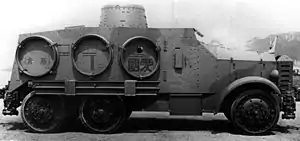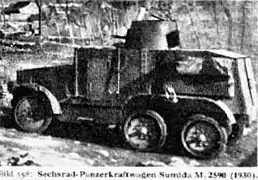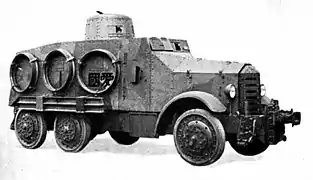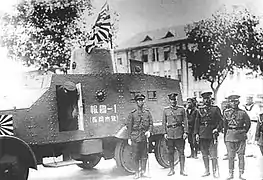Sumida M.2593
The Sumida M.2593 (Type 91) was an armoured car produced in Japan in the 1930s. It could operate on both the roadway and railway lines.
| Type 91 Armoured Car | |
|---|---|
 A Sumida M2593 Armoured Car | |
| Place of origin | Empire of Japan |
| Production history | |
| Designed | 1933 |
| Manufacturer | Ishikawajima Motorcar Factory (l/k/a Isuzu) |
| No. built | 1,000[1] |
| Specifications | |
| Mass | 7.7 tons[2] |
| Length | 6.57 meters[2] |
| Width | 1.9 meters[2] |
| Height | 2.95 meters[2] |
| Crew | 6[2] |
| Armor | 8 mm to 16 mm (front)[2] |
Main armament | 1x 6.5 mm machine gun or 1x 7.7 mm machine gun |
Secondary armament | Slits for rifles or light machine guns |
| Engine | 4-cyl gasoline (petrol) 45 hp |
| Suspension | wheeled |
Operational range | 241 km (150 mi) |
| Maximum speed | 40 km/h road, 60 km/h rail[2] |
History
Designed by the Sumiya firm, the M.2593 was produced beginning in 1933 at the Ishikawajima Motor Works. A defining feature of this vehicle is that its six road wheels could be exchanged for flanged railway wheels.[3] When not in use, the tires would be secured to the sides of the hull.[2] The vehicle had four built-in jacks for use when the wheels were changed. It would take ten to twenty minutes to change the wheels.[4] The front and rear sets of wheels could even be adjusted to various rail gauges. The car was capable of 25 mph (40 km/h) on road and traveling at higher speeds on rails, going up to 37 mph (60 km/h).[2]
The car was successful in covering great distances in the 1937 invasion of China. They were also used in Manchuria, to "guard railway lines".[1] They could be coupled together and operate on the rails like "rolling stock". This led them to be used in joint operations with trains and were used for reconnaissance by the army.[2] The M.2593 had a crew of six men, and was armed with either one 6.5 mm machine gun[2] or one 7.7 mm machine gun.
Variants
One version, the Type 91 Armored Railroad Car So-Mo was produced without a main fixed machine gun for armament.[1]
A second variant produced by Ishikawajima was known as the Sumida Model P Armored Car. It was used by the Special Naval Landing Forces (SNLF) of the Imperial Japanese Navy (IJN).[5]
Gallery
 Sumida M.2590 (1930)
Sumida M.2590 (1930) Side view of a Sumida M.2593
Side view of a Sumida M.2593 Sumida Model P Armored Car of the SNLF (1932)
Sumida Model P Armored Car of the SNLF (1932) Sumida Model P Armored Car of the SNLF on patrol
Sumida Model P Armored Car of the SNLF on patrol Sumida M.2593 hooked in tandem to another Type 91 (1933)
Sumida M.2593 hooked in tandem to another Type 91 (1933)
Notes
- Taki's Imperial Japanese Army: Type 91 Armored Railroad Car
- Tomczyk 2002, p. 87.
- Tomczyk 2002, pp. 80, 83.
- Tomczyk 2002, pp. 85, 87.
- Taki's Imperial Japanese Army: Sumida Model P Armored Car
References
- Tomczyk, Andrzej (2002). Japanese Armor Vol. 1. AJ Press. ISBN 83-7237-097-4.
- Trewhitt, Philip, and Chris McNab (2004). Fighting Vehicles of the World: over 600 Tanks and AFVS of the World. London: Amber.